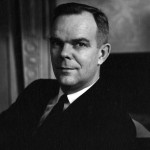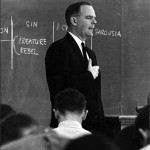How did an expert in the New Testament and Luther become a Lutheran ecumenical leader? At least two reasons. After World War II U. S. Lutherans played a major role in diaconal, missionary, and refugee work; now they were ready to become involved in wider leadership in the Lutheran world. And around 1960 a new generation of theological leaders was about to step onto the stage. Quanbeck was one of this new generation, but ten years ahead, prepared to take part in this developing American Lutheran role. That was not without its problems. He liked to point out that because he had been cleared of “liberalism” by the ELC’s council of district presidents, he was one of the few who could state for sure that he was not a heretic.
 World Lutheranism. From 1958-1970 he was a member of the LWF Commission on Theology. As such he was directly involved at the LWF Assembly in Helsinki (1963) in the famous or “infamous” statement on justification, which was much maligned by press reports claiming that Lutherans had been unable to agree on their key doctrine of justification. But Quanbeck noted that the Helsinki Assembly actually succeeded in its purpose, which was to place justification in its contemporary theological and cultural context. He was on the Board of Trustees of the LWF Foundation for Interconfessional Research, Strasbourg (1959-1971). At the LWF Assembly in Evian (1970) he was chairman of Section Two, Ecumenical Affairs. From 1971-1972 he was the LWF Lutheran Lecturer at Mansfield College, Oxford.
World Lutheranism. From 1958-1970 he was a member of the LWF Commission on Theology. As such he was directly involved at the LWF Assembly in Helsinki (1963) in the famous or “infamous” statement on justification, which was much maligned by press reports claiming that Lutherans had been unable to agree on their key doctrine of justification. But Quanbeck noted that the Helsinki Assembly actually succeeded in its purpose, which was to place justification in its contemporary theological and cultural context. He was on the Board of Trustees of the LWF Foundation for Interconfessional Research, Strasbourg (1959-1971). At the LWF Assembly in Evian (1970) he was chairman of Section Two, Ecumenical Affairs. From 1971-1972 he was the LWF Lutheran Lecturer at Mansfield College, Oxford.
Roman Catholicism. Quanbeck was a LWF Delegate Observer at the last three of the four sessions of Vatican Council II (1961-1965), in his own words “the single most important theological occurrence of the twentieth century.” The observers met weekly for two to three hours with Roman Catholic bishops and staff of the Secretariat for Christian Unity, and they had a definite influence not only on the decree on ecumenism but also on the constitution on the nature of the Church. When, immediately after Vatican II, the US Lutheran/Roman Catholic Dialogue began, he was an obvious member. The Catholics challenged us by “running in their first team,” he stated, and, because over half of the members had learned to trust each other through contact at Vatican II, the usual maneuvering and hesitation at the start of a dialogue process could be bypassed.
 World Council of Churches. He was a member of the WCC Faith and Order Conferences at Oberlin (1957) and Montreal (1963). From 1958-1959 he was tutor at the WCC Ecumenical Institute, Celigny, Switzerland. He was a delegate to the WCC Assembly at Nairobi (1975) and elected there to the Central Committee of the WCC.
World Council of Churches. He was a member of the WCC Faith and Order Conferences at Oberlin (1957) and Montreal (1963). From 1958-1959 he was tutor at the WCC Ecumenical Institute, Celigny, Switzerland. He was a delegate to the WCC Assembly at Nairobi (1975) and elected there to the Central Committee of the WCC.
This listing, this “ecumenical bibliography,” is in no sense complete. Quanbeck was also, for example, a member of the US Lutheran/Presbyterian Dialogue from 1962-1966. But what this listing does begin to show is how he became a Lutheran Ambassador-at-large. Not only was he directly involved with Lutherans at the world level; he was also involved with Roman Catholics, Anglicans, the Reformed, and, through the WCC, with the Orthodox at the world level. Today, when it is frequently feared that ecumenism is “in a deep freeze” and its future is difficult to discern, it is important to look back two generations to a leader like Quanbeck who, to be sure, was standing on the shoulders of the giants before him, yet who also used his diplomatic skills to build bridges and forge deep personal bonds with other Christian leaders. Then, too, the battles were fierce. Could we trust the Roman Catholics? Would the Orthodox find their way into the ecumenical movement? Where were the Reformed going, anyway? What about apartheid and racism?
What was needed was trust. What Warren Quanbeck was able to develop, as a kind of Lutheran Ambassador-at-large, was the confidence of those he spoke for, the Lutheran leaders who had come to know his work. At the same time he was able to gain the trust of ecumenical partners. It was not simply a matter of endless travel, endless meetings, more debate and more written statements of agreement. It was most of all a kind of ecumenical perception and integrity, learned and communicated. He wove a net of ecumenical alliances, bridges for wider Lutheran ecumenism.
But he was also a baseball fan, a skilled pianist, a frustrated architect, a social activist, a ready wit. And, not to be forgotten, he was an inspiring teacher (Professor, first of New Testament, subsequently Systematic Theology, Luther Seminary, St. Paul, 1948 -1979).
***
This article appeared in The Metro Lutheran 25:6 (June 2010) 5. In that article, however, the date which he became a full professor at Luther Seminary is incorrectly stated as 1958. It should be 1948 as in the last paragraph above. (In 1948 professors were elected to seminary professorships by the churchwide convention.)